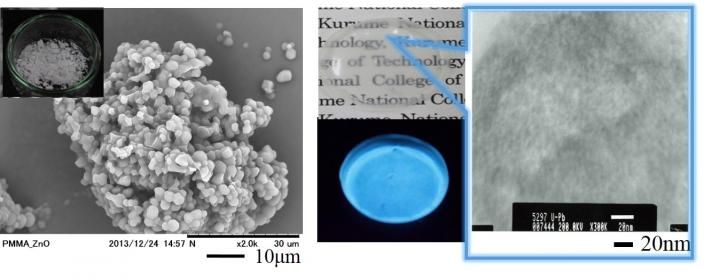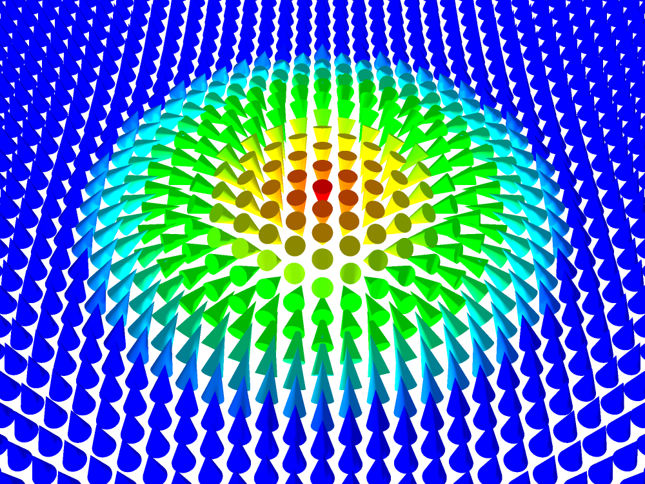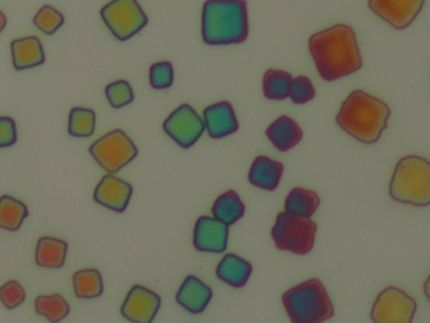Semiconductor nanoparticles show high luminescence in a polymer matrix
Semiconductor nanocrystals known as quantum dots (QDs) are increasingly being used as photoluminescent materials in bio-imaging, photonics, and optoelectronic applications. However, these QDs must have stable photoluminescence properties to be used in these applications. Photoluminescence stability of QDs is achieved by chemically modifying the surface of the QDs.

Polymer-ZnO nanoparticle QDs by dispersion polymerization in supercritical CO2 are shown.
COPYRIGHT (C) 2015 TOYOHASHI UNIVERSITY OF TECHNOLOGY. ALL RIGHTS RESERVED.
However, chemical modification of the surface typically requires large amounts of organic solvents that are harmful to the environment. To solve this problem, many researchers have attempted to synthesize polymer-nanoparticle composites by using supercritical fluid (SCF)-based technology. Supercritical CO2 has emerged as the most extensively studied SCF medium, because it is readily available, inexpensive, nonflammable, and environmentally benign.
Toyohashi Tech researchers in cooperation with researchers at the National Institute of Technology, Kurume College have investigated the formation of nanostructured material using supercritical CO2. They have demonstrated the formation of composite nanoparticles of luminescent ZnO QDs and polymer by dispersion polymerization in supercritical CO2. As a result of the supercritical-CO2-assisted surface modification of QDs, the QDs were well dispersed in the polymer matrix and showed high luminescence.
"Unfortunately, the photoluminescence properties of pristine luminescent QDs were quenched in supercritical CO2. The surface structure of the QDs was destroyed by supercritical CO2.", explains associate professor Kiyoshi Matsuyama at the National Institute of Technology, Kurume College, "We found that the quenching of ZnO QDs could be prevented by coating with silica to obtain PMMA-ZnO composite QDs with high luminescence using a supercritical-CO2-assisted surface modification with polymer."
Our research shows that the supercritical-fluid-assisted process provides an environmentally benign route for producing stabilized luminescent materials.
Original publication
Most read news
Original publication
Kiyoshi Matsuyama, Yu-ki Maeda, Takaaki Matsuda, Tetsuya Okuyama, Hiroyuki Muto; "Formation of poly(methyl methacrylate)-ZnO nanoparticle quantum dot composites by dispersion polymerization in supercritical CO2"; The Journal of Supercritical Fluids; 2015
Organizations
Other news from the department science
These products might interest you

NANOPHOX CS by Sympatec
Particle size analysis in the nano range: Analyzing high concentrations with ease
Reliable results without time-consuming sample preparation

Eclipse by Wyatt Technology
FFF-MALS system for separation and characterization of macromolecules and nanoparticles
The latest and most innovative FFF system designed for highest usability, robustness and data quality

DynaPro Plate Reader III by Wyatt Technology
Screening of biopharmaceuticals and proteins with high-throughput dynamic light scattering (DLS)
Efficiently characterize your sample quality and stability from lead discovery to quality control

Get the chemical industry in your inbox
By submitting this form you agree that LUMITOS AG will send you the newsletter(s) selected above by email. Your data will not be passed on to third parties. Your data will be stored and processed in accordance with our data protection regulations. LUMITOS may contact you by email for the purpose of advertising or market and opinion surveys. You can revoke your consent at any time without giving reasons to LUMITOS AG, Ernst-Augustin-Str. 2, 12489 Berlin, Germany or by e-mail at revoke@lumitos.com with effect for the future. In addition, each email contains a link to unsubscribe from the corresponding newsletter.
Most read news
More news from our other portals
Last viewed contents
Bitter_orange
Therapeutic_food
Methacholine
Psilocybin

How the detergent of the atmosphere is regenerated - Juelich troposphere researchers demonstrate effective recycling of radicals during isoprene degradation

Scientists show how to store liquid fuels in polymeric gels to prevent explosions and fires - Researchers from Japan investigate a new safer way to transport and store fuels
Sodium_thiopental
Wikipedia:Featured_articles
New material could boost data storage, save energy


























































